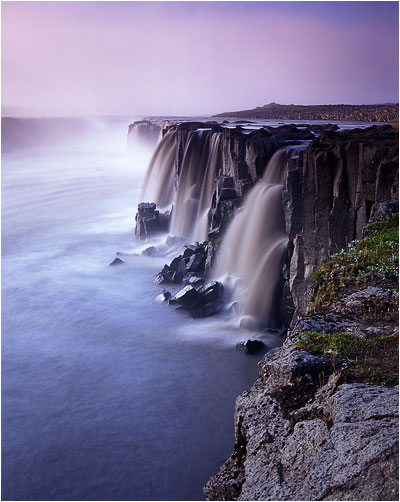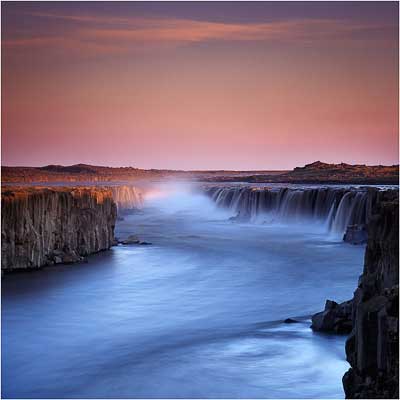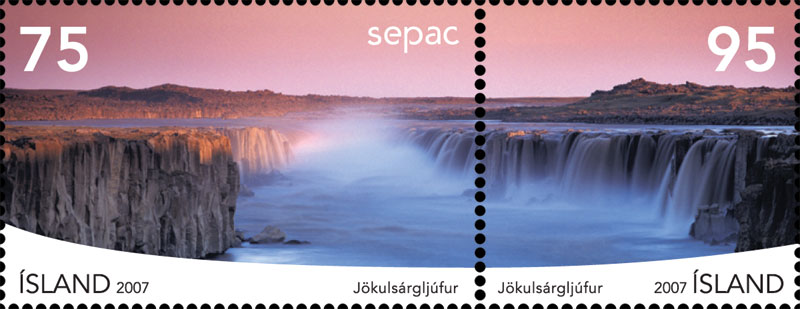Dalkúr & Þóristíndur are two mountains in the Veiðivötn area of Iceland. Veiðivötn means 'fishing waters or lakes'. It is an immense landscape of black desert that stretches for as far as the eye can see. It´s beautifully stark, one of those places where you become very very quiet the first time you enter. For all around you is abundant space with just very subtle gradual changes in dark grey and sometimes faintly dark brown desert. If there is colour to be found here, it is in the form of iron ore brush strokes, often highlighted on the side of small black volcanic cones that occasionally dot the landscape.
Dalkúr & Þóristíndur are two mountains quite visible from the highland-road - an unsealed track made up of nothing more than tyre tracks from high clearance vehicles that manage to make it out to this place.
I'm not one for shooting towards the light. I call this 'shooting against the light' as it always feels as if the direction of travel of the light photons is against me. This kind of shooting results in extremely contrasty light, which I often find very hard to control during exposure and afterwards in the digital darkroom. But Veiðivötn encourages me to do just that because the sand is so dark that hardly any light reflects back from it. Contrasts are required, otherwise the final negatives may appear to be extremely flat.
With this shot, my photo group and myself made a brave attempt to shoot this while rain fronts were coming in every 10 minutes or so. The rain was obviously coming in our direction because the laws of the universe state that wherever you wish to point your camera, the wind and rain direction will always be lined up to land on your lens! So we had to repeatedly dry the lenses off and hope that some of our captures would not have any rain drops.
But most importantly for me was the need to control the contrasts. This shot was taken at a lull in the intensity of backlighting that was occurring. Sometimes the sun would poke right through the background cloud cover so much that I new there was no point in shooting. From a learning perspective, I should stress that when the light looks good to our eyes, it is often still too extreme in contrast. So I waited until the clouds began to cover the sun up so much that the contrast effect was at its lowest. Although the light may appear less exciting and not worth taking, it is the perfect time to capture something that has good dynamic range on your film or sensor, and still maintain the dramatic impression you felt whilst there.
Stac Pollaidh and Cul Mhor, Loch Bad a Ghaill, Inverpolly, Scotland. 2015. Image © Michael Kenna 2015
On a side note: last year while I spent a very enjoyable week with Michael Kenna in the landscapes of the north west of Scotland, it was interesting to note that he prefers this kind of light. He is a black and white shooter, which often means he is looking for contrasts. I hadn't appreciated just how much though until I saw one of his images taken of a place I know so well, shot in the early morning with the sun coming up behind the mountain. This location I prefer to shoot when the sun is behind me, while Michael preferred it backlit. Somehow I feel my time with Michael may be the reason why I chose to shoot Dalkúr & Þóristíndur with backlighting. I often feel things are learned by absorption.
Back to my image. I also loved the boulder patch below the mountains. With backlit light they stand out and provide another contrast to the picture. They also provide an elegant arc that is the inverse of the curve of the skyline.
These boulder patches are few: you can drive for miles and just encounter empty desert and then out of the blue, there's a small boulder patch sitting on its own. This is similar to the Bolivian Altiplano, with both landscapes, perplexing things happen where rocks appear to lie in places with no relation to the surrounding landscape.
Interestingly for me, I find Veiðivötn to be the antithesis of the Bolivian altiplano in terms of colour and tone. Both are vast empty minimal places and they feel like brother and sister to me, only with the Altiplano I'm encouraged to open up the tones and shoot the bright colour landscape, whereas with Veiðivötn, its power is in its shadows and mysterious dark tones. It is a landscape full of suggestion, a place where the mind wishes to peer below the surface, and on each visit there, I feel as though I have yet to scratch below the surface of what is there.





















